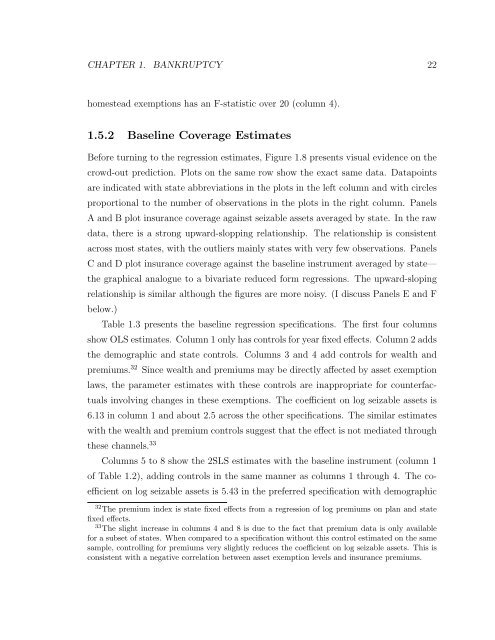essays in public finance and industrial organization a dissertation ...
essays in public finance and industrial organization a dissertation ...
essays in public finance and industrial organization a dissertation ...
Create successful ePaper yourself
Turn your PDF publications into a flip-book with our unique Google optimized e-Paper software.
CHAPTER 1. BANKRUPTCY 22<br />
homestead exemptions has an F-statistic over 20 (column 4).<br />
1.5.2 Basel<strong>in</strong>e Coverage Estimates<br />
Before turn<strong>in</strong>g to the regression estimates, Figure 1.8 presents visual evidence on the<br />
crowd-out prediction. Plots on the same row show the exact same data. Datapo<strong>in</strong>ts<br />
are <strong>in</strong>dicated with state abbreviations <strong>in</strong> the plots <strong>in</strong> the left column <strong>and</strong> with circles<br />
proportional to the number of observations <strong>in</strong> the plots <strong>in</strong> the right column. Panels<br />
A <strong>and</strong> B plot <strong>in</strong>surance coverage aga<strong>in</strong>st seizable assets averaged by state. In the raw<br />
data, there is a strong upward-slopp<strong>in</strong>g relationship. The relationship is consistent<br />
across most states, with the outliers ma<strong>in</strong>ly states with very few observations. Panels<br />
C <strong>and</strong> D plot <strong>in</strong>surance coverage aga<strong>in</strong>st the basel<strong>in</strong>e <strong>in</strong>strument averaged by state—<br />
the graphical analogue to a bivariate reduced form regressions. The upward-slop<strong>in</strong>g<br />
relationship is similar although the figures are more noisy. (I discuss Panels E <strong>and</strong> F<br />
below.)<br />
Table 1.3 presents the basel<strong>in</strong>e regression specifications. The first four columns<br />
show OLS estimates. Column 1 only has controls for year fixed effects. Column 2 adds<br />
the demographic <strong>and</strong> state controls. Columns 3 <strong>and</strong> 4 add controls for wealth <strong>and</strong><br />
premiums. 32 S<strong>in</strong>ce wealth <strong>and</strong> premiums may be directly affected by asset exemption<br />
laws, the parameter estimates with these controls are <strong>in</strong>appropriate for counterfac-<br />
tuals <strong>in</strong>volv<strong>in</strong>g changes <strong>in</strong> these exemptions. The coefficient on log seizable assets is<br />
6.13 <strong>in</strong> column 1 <strong>and</strong> about 2.5 across the other specifications. The similar estimates<br />
with the wealth <strong>and</strong> premium controls suggest that the effect is not mediated through<br />
these channels. 33<br />
Columns 5 to 8 show the 2SLS estimates with the basel<strong>in</strong>e <strong>in</strong>strument (column 1<br />
of Table 1.2), add<strong>in</strong>g controls <strong>in</strong> the same manner as columns 1 through 4. The co-<br />
efficient on log seizable assets is 5.43 <strong>in</strong> the preferred specification with demographic<br />
32The premium <strong>in</strong>dex is state fixed effects from a regression of log premiums on plan <strong>and</strong> state<br />
fixed effects.<br />
33The slight <strong>in</strong>crease <strong>in</strong> columns 4 <strong>and</strong> 8 is due to the fact that premium data is only available<br />
for a subset of states. When compared to a specification without this control estimated on the same<br />
sample, controll<strong>in</strong>g for premiums very slightly reduces the coefficient on log seizable assets. This is<br />
consistent with a negative correlation between asset exemption levels <strong>and</strong> <strong>in</strong>surance premiums.










